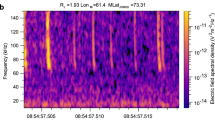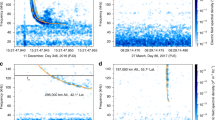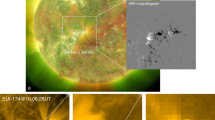Abstract
The possible occurrence of lightning in the Venus atmosphere has long been a subject of speculation1,2, so the initial reports of impulsive electromagnetic signals deep in the Venus atmosphere3 and in the night ionosphere4 generated much interest. The results of optical experiments, however, were mixed. The infrared spectrometer on Venera 9 observed one sequence of lightning-like activity5. The star-sensor of the PVO orbiter6 saw none and the Vega balloon photometers7 obtained negative but ambiguous results. Evidence for the lightning generation of the electromagnetic signals includes their impulsive nature, their occurrence patterns8,9, their altitude dependences8,10 and their electromagnetic polarization11. Although only signals below several hundred hertz can directly propagate to the PVO spacecraft, higher frequency signals could scatter in the inhomogeneities of the night ionosphere12. As these higher frequencies cannot propagate far into the ionosphere and are seldom observed at altitudes of above 400 km (ref. 13) they mark the location of the generating region. In this paper we map the locations of the observations made at 730 Hz during the first three night-time observing seasons of Pioneer Venus, when the spacecraft reached altitudes low enough to detect these leakage signals. These maps show that there are specific 'active regions' of enhanced signal occurrence and that at least some of these active regions appear to remain fixed in planeto-graphic coordinates from year to year.
This is a preview of subscription content, access via your institution
Access options
Subscribe to this journal
Receive 51 print issues and online access
$199.00 per year
only $3.90 per issue
Buy this article
- Purchase on Springer Link
- Instant access to full article PDF
Prices may be subject to local taxes which are calculated during checkout
Similar content being viewed by others
References
Meinel, A. B. & Hoxie, D. T. Comm. Lunar Planet. Lab., Univ. Arizona 1, 35–38 (1962).
Davidson, G. T. & Anderson, A. D. Science 156, 1729–1730 (1967).
Ksanfomaliti, L. V. Kosm. Issled. 17, 747–762 (1979).
Taylor, W. W. L., Scarf, F. L., Russell, C. T. & Brace, L. H. Science 205, 112–114 (1979).
Krasnopol'skii, V. A. Kosm. Issled. 18, 429–434 (1980).
Borucki, W. J., Dyer, J. W., Thomas, G. Z., Jordan, J. C. & Comstock, D. A. Geophys. Res. Led. 8, 233–236 (1981).
Sagdeev, R. Z. et al. Science 231, 1411–1414 (1986).
Ksanfomaliti, L. V., Scarf, F. L. & Taylor, W. W. L. in Venus (eds Hunten, D. M., Colin, L., Donahue, T. M. & Moroz, V. I.) 565–603 (Univ. Arizona, Tucson, 1983).
Scarf, F. L. & Russell, C. T. Geophys. Res. Lett. 10, 1192–1195 (1983).
Scarf, F. L., Jordan, K. F. & Russell, C. T. J. geophys. Res. 92, 12407–12411 (1987).
Scarf, F. L. & Russell, C. T. Science (in the press).
Singh, R. N. & Russell, C. T. Geophys. Res. Lett. 13, 1071–1074 (1986).
Russell, C. T., von Dornum, M. & Scarf, F. L. J. geophys. Res. (in the press).
Borucki, W. J. Icarus 52, 354–364.
Author information
Authors and Affiliations
Rights and permissions
About this article
Cite this article
Russell, C., von Dornum, M. & Scarf, F. Planetographic clustering of low-altitude impulsive electric signals in the night ionosphere of Venus. Nature 331, 591–594 (1988). https://doi.org/10.1038/331591a0
Received:
Accepted:
Issue Date:
DOI: https://doi.org/10.1038/331591a0
This article is cited by
-
Signatures of solar wind interaction with the nightside ionosphere of Venus
Earth, Moon, and Planets (1995)
-
Optical searches for venusian lightning: implications for nightside field and plasma relationships
Earth, Moon, and Planets (1994)
-
Lightning-generated waves escaping out through plasma holes in the nightside Venus ionosphere
Journal of Earth System Science (1991)
-
Radioemission source disputed
Nature (1990)
-
Radioemission source disputed
Nature (1990)
Comments
By submitting a comment you agree to abide by our Terms and Community Guidelines. If you find something abusive or that does not comply with our terms or guidelines please flag it as inappropriate.



